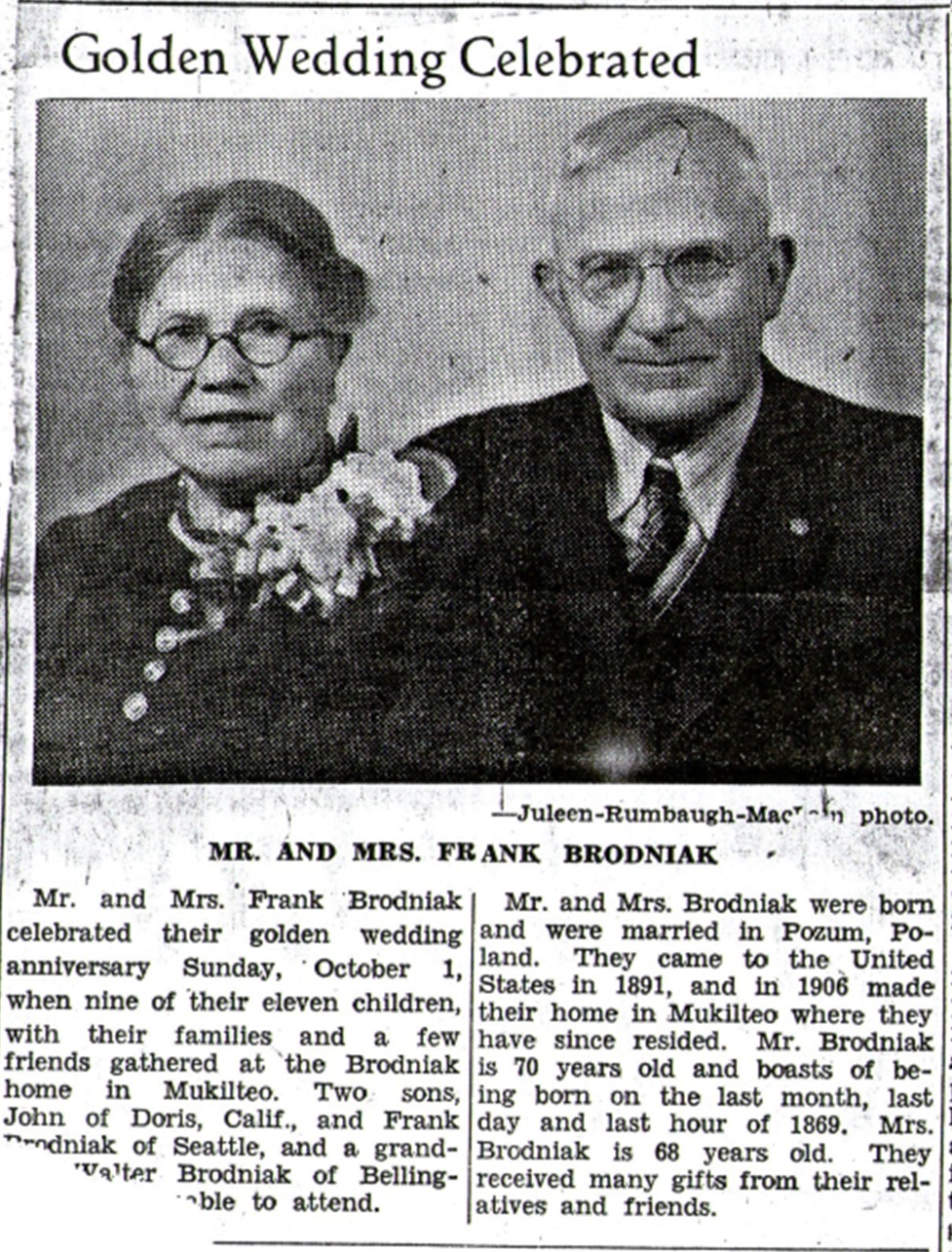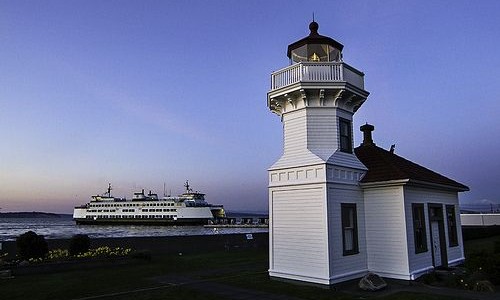By Margaret Summitt, Mukilteo Historical Society
Crown Lumber attracted laborers from all over the world. The best known are the Japanese workers who came to Mukilteo in the early 1900s. Not so well known are the Poles. About six interconnected families of Polish descent, now blended into Mukilteo’s history, came here from one county in Minnesota. They came for jobs in the lumber mill and stayed to build our community.
Using U. S. Census records, I found a number of families with Polish origins who were neighbors in Mukilteo in 1910. Ten years earlier, in 1900, they were neighbors in Otter Tail County, Minnesota. These families, in alphabetical order, were the Brodniaks, the Goralskis, the Niedzielskis, , the Pokswinskis, the Rogalskis, and the Wilkowskis.
These families came from Posen Province in Prussia, which today is in the western part of Poland. In the late 1800s this area was under German control. The Poles were the majority of the population, but the Germans ran things. For 45 to 60 dollars an emigrant family might travel as far as Minnesota. Minnesota has forests, lakes and a climate like Poland’s.
Pine and hardwood forests in Minnesota and the Northern Pacific depot in Perham, Minnesota, were the connection between Otter Tail County and Mukilteo. Otter Tail County, in southwest Minnesota, was considered a prime location for the construction of lumber mills. Logs were floated south down the Otter Tail River to the Red River, which flowed northward into Canada.
The Northern Pacific rail line ran directly from Perham, Minnesota to Mukilteo. When the lumber mill opened in Mukilteo in 1903, workers were brought in from many places. I imagine someone got off the train in Perham and told the Polish community about opportunities in Mukilteo, saying: there’s a new lumber mill in Mukilteo and they’re hiring!
Perham, Minnesota was founded in 1871. St. Stanislaus was the Catholic parish that the Poles attended. The parish was established in 1884 and at that time there were 150 families. St. Henry’s was the German Catholic parish. A census of German and Polish Catholics was taken in Minnesota as part of an effort to get more German and Polish bishops appointed; at that time the Irish dominated the hierarchy. Today about 3.5% of the Otter Tail County population claims Polish ancestry.
The Goralski, Wilkowski and Niedzelski families, who came to Mukilteo, were next door neighbors in Otter Tail County in the 1900 Census. The Pokswinski family was also living in Perham, Minnesota, in 1900.
The Wilkowskis and Niedzelski families were neighbors in Mukilteo in the 1910 Census. The Goralski family was still in Otter Tail County in 1910; Frank Goralski was in Detroit in 1920 and in Mukilteo by 1930. By 1930 the rest of the complement was here.
Let’s look at the significance of two of the families: the Pokswinskis and the Brodniaks.
Pelagia (Wilkowski) Pokswinski was the sister of Edward and Francis Wilkowski. She was born about 1871 in Poland and died 11 Nov 1953 in Everett. Pelagia was the wife of Franciszek Pokswinski. Pelagia’s daughters were Cecilia Maryanna who married Carl Kasch in 1912 (of Kasch Park fame, near the Boeing plant) Clara who married Bartle Kane in 1917, and Delia who married Ray Hughes about 1928.
Clara Kane was the mother of Ronald Kane, who was mayor in the 1960s. She was chosen Citizen of the Year in 1972. That year the Pioneer Days honored the former residents of Japanese Gulch, and Clara Kane was a special guest. Clara had befriended and taught English to many of the Japanese boys and girls she grew up with in the 1920s and 30s. These families left Mukilteo after the Crown Lumber mill closed in 1930. One of these friends was George Tokuda. She had not heard from him for some time when, in April 1943, she received a letter written in the Minidoka Relocation Center in Hunt, Idaho. “Remember me?” George’s letter began.
“This is the kid who used to haunt your home day and night, the one who formerly raided your cherry orchard, the one that was always at your door the day you baked those delicious home made breads; the kid who to this day often reminisces about those boyhood days when life was so beautiful and full of anticipation and dreams. Today, a little bitter perhaps, but still hopeful, I am living in this concentration camp, looking only for the day when that day of freedom will again be mine. Fortunately, the parents, brother, his wife and I are in the best of health. Here’s hoping that your family and the Pokswinskis are all well.”
The Pokswinskis resided on Fifth Street in 1930. By 1940, when Clara received this letter, she was living at 148 Sixth Street, near her mother, who was living with her daughter Angeline (Pokswinski) Cole. Two photos in the Historical Society collection, taken by old-timer Bevo Dudder Ellis in 1975, show the Pokswinski home at 6th and Cornelia.
The Brodniak family came to stay and their family is still around. Frank and Hattie Brodniak were born in Posen Province, in what is now western Poland. Frank had an older brother named Anton Brodniak, who, when their families arrived in New York in 1891, decided to settle in Perth Amboy, New Jersey.
Frank and Hattie lived briefly in Thurber, Texas before coming to Minnesota. Between 1888 and 1921 Thurber, Texas was one of the largest producers of bituminous coal in Texas and the largest company town in the state. It had a large Polish community among other ethnic communities. Today it is a ghost town.
The 1900 Census finds the Brodniak family at Gorham, in Otter Tail County, Minnesota. Frank was a day laborer. The children numbered five at that time: Thomas, Pelagia, Andrew, Mary and John.
They left for Mukilteo in 1906. Frank came first and stayed in Mrs. Gongla’s rooming house; when Hattie came later with their (by then, eight) children, they rented a house down by the railroad. Frank Brodniak then built a house at 1002 Fifth Street, where children Barbara and Wallace “Wally” Brodniak were born. Frank worked at Crown Lumber and the children all attended the Rosehill School, and the sons worked for Crown Lumber. Wallace “Wally” Brodniak was a co-Citizen of the Year in 1974 with Jack Gribble.

Daughters Pauline and Mary Brodniak worked at McDonald’s Restaurant on the waterfront, and later at Butler’s Hotel with Frances Sinclair and Vi Riches. Daughter Barbara Brodniak was a waitress in Seattle in 1940 and married for the first time in 1949 to Everett Ace Chamberlain.
The Brodniaks and Goralskis were active in Mukilteo’s baseball team. This was a team of mill workers whose main rival was the mill team from Port Angeles. In the front row of the 1921 team photo we see Frank Brodniak, Frankie Goralski and John Brodniak. Love the striped socks.
Johnnie Brodniak is the boy on the far right in the front row. At the age of fourteen he was an avid reader of the Seattle Star newspaper. “Uncle Jack” was the handle of the children’s page editor. Johnnie wrote to “Uncle Jack” in 1913 boasting of his artistic ability. “Dear Uncle Jack: We have been taking The Star for the last four years and found it a good paper. I am a Mukilteo boy, 14 years old, and in the eighth grade. I am the boy that got Clarence Brennan to join, and so I thought I would join myself. At school we are the best in drawing. We stay in at recess every day and draw pictures of each other and other things. We have won prizes in drawing at school. Please send me a membership card—John Brodniak, Mukilteo, Wash., Box No. 3.”
John went on to work in lumber mills and by 1938 he was in home construction in southern Oregon.
Crown Lumber closed in 1930 but the Polish community lived on; it just blended in so well over the years as to lose its visibility. The Rosehill School is no longer a school but Rosehill is still a focal point of Mukilteo. The baseball team, which Crown Lumber sponsored, is also gone. But we still have a Lighthouse Festival to honor our pioneers. So remember the Polish community.
Originally published in the 10/3/2018 issue of the Mukilteo Beacon.
